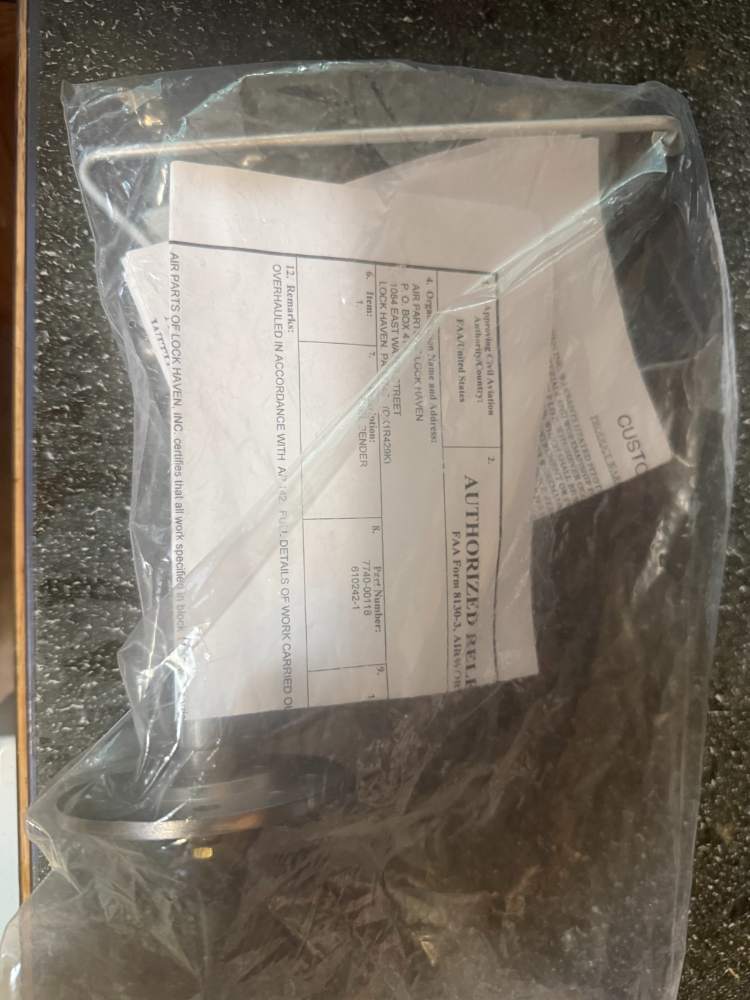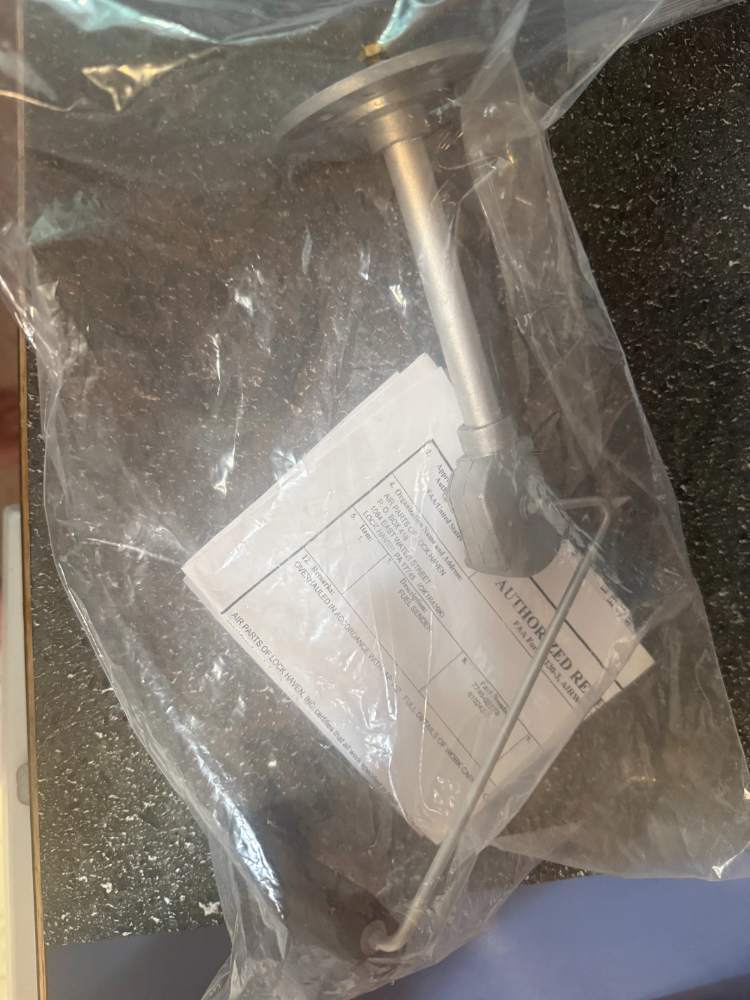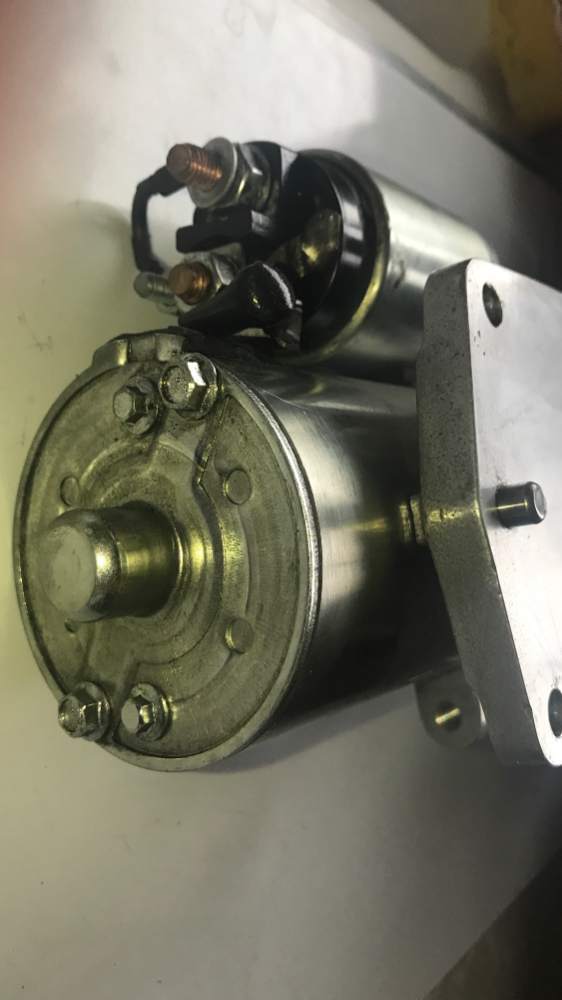-
Posts
1,846 -
Joined
-
Last visited
-
Days Won
3
Content Type
Profiles
Forums
Blogs
Gallery
Downloads
Media Demo
Events
Everything posted by M20F-1968
-
That is all you need. Just get accustomed to how it reads and set it accordingly. John Breda
-
I had the opposite experience. When I did my rebuild, I took the baggage door off a 1998 Ovation. The pulled the hinge pin and mounted a new 1/2 of the airframe side of the hinge to the airframe and left the door completely alone, even the door seal. It remains this way today. The door seals well and fits the opening well too. My experience is one of one, but it would seem that a used door would likely fit. The door swap also gave me the new latch mechanism with the inside opening handle as well. The passenger door was more complicated as I reskinned my original door and put in the Ovation hardware - but that was a different project. John Breda
-
The "sacrificial blocl" is made from bakelite type material and is quite abrasive in and of itself. When I rebuilt my plane I made new nylon blocks with DER signoff. Much less abrasive and have not had issues. John Breda
-
I had just this problem when I rebuilt my F. We used new springs and the push rods that were in the airplane. It was a two person job to get the gear up, which was obviously unacceptable. We researched the landing gear blueprints at the factory and found that even though there were two fuselage lengths there were three different lengths of the push rods that compress the springs. My feeling was that given the these airplanes are essentially man-made, there are some tolerance differences. The other issue to consider is that mine is a 68F and the Johnson bar is different for that year only. The bottom line is we had installed the middle length of retraction rods compressing pushing the springs, and made some spacers to see what would happen if the springs were compressed a little more. That made all the difference in the world. The difference was beforehand. It took two people in two hands to put the gear up. After the adjustment, the gear could be put up with two fingers. My mechanic went to Dugosh and dug through their old parts and found a set of the longest compression push rods and install those. To this day I put up the gear with two fingers. If you cannot find the longer rod, simply use the shorter or mid length rod, cut it, weld it and make it longer. I doubt anything is bent. You likely have the wrong compression rods in the airplane. John Breda
-
You can at times by undrilled skins. It is worth a try to ask for undrilled seat rails so they can be match drilled ti what is in the floor. They likely will not sell them without the holes for the seat pins but you would not want them to as those holes must be accurately drilled so the pins fit in correctly. John Breda
-
I am interested in a scanned version. My e-mail is john.breda@gmail.com I am also willing to do the scanning work is that is helpful. John Breda
-
The seat rails are all made from the same extruded aluminum supply stock. The difference is how they are finished milled and cut for size and length. I would find someone knowledgeable at the factory to help you identify a new part that can be modified to fit into your installation. I suspect it will be a PITA to find someone to do the work of looking into current stock (if there is any) to find something workable. The best solution is if the factory will sell you undrilled seat rails and the find a local machine shop to to the machine work to duplicate them. John Breda
-

Interior firewall insulation replacement
M20F-1968 replied to Matthew P's topic in Vintage Mooneys (pre-J models)
I did this then in rebuilt the airframe. I made a firewall blanket from soundproofing material. It was installed after the firewall was in stalled but before the avionics were installed , as I remember. I would need to check my old pictures of the project to verify. However, you need to deal with what you have. You can make a firewall blanket and slide it between the firewall and the avionics and wires. The old firewall sound-proofing must be removed. It can be installed with threaded fasteners (machine screws) appropriate for high temperature installation. You will not need many fasteners. The firewall blanket can be made in sections so it is easier to install, but I can assure you it will be a PITA to install. You might find a young, small, flexible, and willing assistant to help. As you already know, working behind the panel in a Mooney is always challenging. It's the price you pay for a small frontal area and speed. John Breda -

Interior firewall insulation replacement
M20F-1968 replied to Matthew P's topic in Vintage Mooneys (pre-J models)
I did this then in rebuilt the airframe. I made a firewall blanket from soundproofing material. It was installed after the firewall was in stalled but before the avionics were installed , as I remember. I would need to check my old pictures of the project to verify. However, you need to deal with what you have. You can make a firewall blanket and slide it between the firewall and the avionics and wires. The old firewall sound-proofing must be removed. It can be installed with threaded fasteners (machine screws) appropriate for high temperature installation. You will not need many fasteners. The firewall blanket can be made in sections so it is easier to install, but I can assure you it will be a PITA to install. You might find a young, small, flexible, and willing assistant to help. As you already know, working behind the panel in a Mooney is always challenging. It's the price you pay for a small frontal area and speed. John Breda -

201 Removable Back Seats In An E?
M20F-1968 replied to akb3's topic in Vintage Mooneys (pre-J models)
I installed a complete Ovation interior into a 1968 M20F. Take a look at my profile pictures. Yes it can be done. It is a lot of work however. There are also several versions of rear seats. Seats from the later models are most desirable. John Breda -
After reading this threat, I think I might consider taking my wing covers with me on any long trips away from home. Need to check the weight of the covers. If in place, they should protect against water. The weather seems to be getting worse in the middle of the US, with weather then coming east. Finding hangar space is unpredictable. John Breda
-
The first place to look when a small amount of oil is dripping from the exhaust pipe is the check valve with oil going to turbo. It is a plunger/spring type assembly. John Breda
-
I have 2 senders, Part No. 610242-1. Both have been rebuilt by Airparts of Lockhaven with paperwork for return to service. I also have one as removed. $250 each for the rebuilt on. $100 for the as removed of B/O fir that one. These are the last of the senders I have. They are legal to put in an F. The only other senders I would use are the CIES senders (which I now have) but you also need a digital system which you likely do not have. I would just take all 3, The prices have gone crazy. You will then have an extra to readily install and an extra to rebuild. John Breda cell: (617) 877-0025 email: john.breda@gmail.com
-

Replacing my starter - what to buy?
M20F-1968 replied to bd32322's topic in Modern Mooney Discussion
I have a almost new Sky-Tec Aircraft Lightweight Starter Model 149-12LS Sky-Tec light weight starter which is like new. I replaced my original starter with this new on. It was on the airplane no more that about 20 hours when I built a new baffling which needed an inline starter - airbox and air filter which required an in line starter due to lack of space for the solenoid position on this starter. Please see the Aircraft Spruce page for this starter with specifications and new pricing. The starter sells currently ar Aircraft Spruce for $1145.00. John Breda cell: (617) 877-0025 email: john.breda@gmail.com -
I am in Boston and have never had a problem with the system in the winter. It is a PITA to maintain and change pumps, but once it works it works. Of great help is to make lines that access all the pressure pot fittings and fittings in the system. I have a large pressure pot and a smaller one for the front. When filing the system, open it in the middle, hooking a line to the outflow of the pump, and push fluid forward bleeding it out the front. Then rehook up the rear line to the pump, and push brake fluid forward and bleed in out the front. The hardest part to prime is the pump itself. John Breda
-

Looking for interior air duct part
M20F-1968 replied to billy hellcat's topic in Vintage Mooneys (pre-J models)
This can easily be made from fiberglass. You will need flame retardant resin and antimony trioxide (as extra flame retardant - hard to find) however. John Breda -
I bought mine at LPAero Plastics when in Oshkosh years ago. Perhaps they still have them.
-
FYI: The claim has been made (by LASAR 20 years ago) that wingtips were not compatible with twisted wing Mooneys such as my 68 F and your 67 F. I never understood that given the nature of the twist, which installed the outer wing section with the outboard forward corner of the wing about 1" lower. That was the only change as I believe. Can anyone explain the incompatibility. (Not that I want to do anything to my plane now, but I might have 20 years ago).
-
I have collected many quality tools over the years of working on the plane during the rebuild and beyond. Many of them are SnapOn bought on e-bay at discount prices. You need to have a keen eye on what is acceptable. You will start to recognize good tools at discount prices that are essentially new. You will also learn what imported brands are actually high quality. The mechanic's work first of all is created in the mind of the mechanic, then comes the plan on how to perform the work. The tools are just a means to an end. But, you will find that the special job that requires a smaller, longer, modified, magnetized, or modified tool will make things easier. It is best when you have taken a section of the airplane apart more than 2 or so times, and know what to, how to do it, and with what tools. John Breda
-
You do not need to take it back out. It is difficult to prime and that is one of the obstacles. The second obstacle is a bend in the tubing near the front of the system. Both can be addressed by opening the system just after the pump by taking off the outflow AN fitting from the pump. You will need to make a new hose with the same type of AN fitting to connect a pressure pot to the pump, and pump new brake fluid forward, directly into and through the pump, and forward filling the brake fluid reservoir and out the reservoir overflow. You will have a clear tube attached to the outflow so you can see when there are no more air bubbles. When that is accomplished, take off the hose from the pump and re-attach the posterior part of the system to the flap pump. Do this quickly so as not to introduce air. Then move your pressure pot to the rear of the system and attach the pressure pot there. Push clean brake fluid from the back to the front until the fluid exiting the reservoir overflow tube is without air bubbles and is clean. Disconnect the pressure pot and seal the system. As I recall, the gear release handle needs to be in the down position to push fluid through the pump (but I may be wrong on this). There are only 2 positions so just try it. Once the pump is primed, the flaps should work directly. You may need to work the flaps and top off the reservoir. It is 4 to 4 1/2 pumps to lock-out. Time retraction per the manual. The adjustment screw is very sensitive. 10-11 seconds to full retraction is about right. Dont try to be cheap on this one. Buy a good pressure pot (BRAKE BLEEDER TANK - Aircraft Tool Co.- aircraft-tool.com) and a smaller pressure pot to fill the reservoir from the front. Most importantly, make up hoses with the proper AN fittings to connect to the hydraulic pump, the rear of the system, and to reservoir - (Vaper 19419 Red Spot Spray Non-Aerosol Sprayer (Red) - 32 oz - Amazon). You will need to find fittings to connect AN Fittings to the can. This will make life much easier, the project go faster, and will eliminate the mess usually made from leaking brake fluid everywhere. You may want to install pressure gauges on each.
-
I have travel boards and was planning on making some for owners needing them, but life gets in the way. I do not lend them or ship them as they are too big, too easily damaged, and too difficult to reproduce to lend or ship out. I do not see being available to make these in the near future (perhaps later in the year when it is warmer and I can get my shop cleaned out and workable) but I may be able to scribe (precisely mark with a sharp scriber) the outline of the travel boards onto marine plywood and make 1:1 cop[ies of the scales and which can be printed onto a suitable material to be mounted onto the boards. You could use that to make a set. I would give you the best location information for mounting the scales based on what I have. Cost would be for the marine plywood (which is what was used by the factory before aluminum), cost of reproducing the scales, my time and shipping. It is not feasible to make a paper template since it will not be sufficiently accurate. It will need to be a direct copy of an original board scribed onto new plywood and cut extremely carefully to the very edge of the scribe mark. It can be cut carefully with a variable-speed jig saw with an appropriate blade or a band saw with a large table.
-
A DER approval based on prior approved data, with the installation inspected by an IA, and paperwork subsequently filed with the FAA is sufficient. The cargo door has always been the same. The difference lies in the locking mechanism. The location of the locking pins remains the same.
-
That solid cable is quite stiff and the bend is likely longer and more subtle to still create binding. Stuff like that takes a lot of patience and time to resolve. I would not rule it out so quickly. Look carefully as to the position of the bend and the potential for binding.











